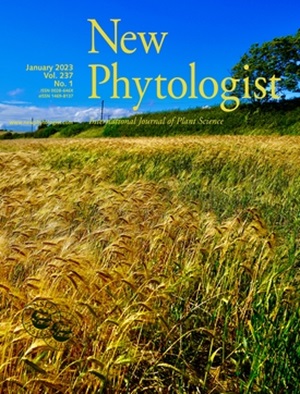Genomic and transcriptomic insights into legume–rhizobia symbiosis in the nitrogen-fixing tree Robinia pseudoacacia
IF 8.1
1区 生物学
Q1 PLANT SCIENCES
引用次数: 0
Abstract
- Robinia pseudoacacia L. (black locust) is a nitrogen (N)-fixing legume tree with significant ecological and agricultural importance. Unlike well-studied herbaceous legumes, R. pseudoacacia is a perennial woody species, representing an understudied group of legume trees that establish symbiosis with Mesorhizobium. Understanding its genomic and transcriptional responses to nodulation provides key insights into N fixation in long-lived plants and their role in ecosystem N cycling.
- We assembled a high-quality 699.6-Mb reference genome and performed transcriptomic analyses comparing inoculated and noninoculated plants. Differential expression and co-expression network analyses revealed organ-specific regulatory pathways, identifying key genes associated with symbiosis, nutrient transport, and stress adaptation.
- Unlike Medicago truncatula, which predominantly responds to nodulation in roots, R. pseudoacacia exhibited stem-centered transcriptional reprogramming, with the majority of differentially expressed genes located in stems rather than in roots. Co-expression network analysis identified gene modules associated with “leghemoglobins”, metal detoxification, and systemic nutrient allocation, highlighting a coordinated long-distance response to N fixation.
- This study establishes R. pseudoacacia as a genomic model for nodulating trees, providing essential resources for evolutionary, ecological, and applied research. These findings have significant implications for reforestation, phytoremediation, forestry, and sustainable N management, particularly in depleted, degraded, and contaminated soil ecosystems.
固氮树种刺槐中豆科植物与根瘤菌共生的基因组学和转录组学研究
刺槐(Robinia pseudoacacia L.)是一种具有重要生态和农业价值的固氮豆科树木。与研究充分的草本豆科植物不同,刺槐是一种多年生木本植物,代表了一种与中根菌建立共生关系的豆科树木。了解其对结瘤的基因组和转录反应,有助于深入了解长寿植物的氮固定及其在生态系统氮循环中的作用。我们组装了一个高质量的699.6 mb参考基因组,并进行了转录组学分析,比较了接种和未接种的植物。差异表达和共表达网络分析揭示了器官特异性调控途径,确定了与共生、营养转运和应激适应相关的关键基因。与主要响应根瘤的短根紫花苜蓿不同,刺槐表现出以茎为中心的转录重编程,大多数差异表达基因位于茎而不是根中。共表达网络分析确定了与“豆血红蛋白”、金属解毒和全身营养分配相关的基因模块,强调了对氮固定的协调远距离响应。本研究确立了刺槐作为结瘤树的基因组模型,为进化、生态和应用研究提供了必要的资源。这些发现对重新造林、植物修复、林业和可持续氮管理具有重要意义,特别是在枯竭、退化和污染的土壤生态系统中。
本文章由计算机程序翻译,如有差异,请以英文原文为准。
求助全文
约1分钟内获得全文
求助全文
来源期刊

New Phytologist
生物-植物科学
自引率
5.30%
发文量
728
期刊介绍:
New Phytologist is an international electronic journal published 24 times a year. It is owned by the New Phytologist Foundation, a non-profit-making charitable organization dedicated to promoting plant science. The journal publishes excellent, novel, rigorous, and timely research and scholarship in plant science and its applications. The articles cover topics in five sections: Physiology & Development, Environment, Interaction, Evolution, and Transformative Plant Biotechnology. These sections encompass intracellular processes, global environmental change, and encourage cross-disciplinary approaches. The journal recognizes the use of techniques from molecular and cell biology, functional genomics, modeling, and system-based approaches in plant science. Abstracting and Indexing Information for New Phytologist includes Academic Search, AgBiotech News & Information, Agroforestry Abstracts, Biochemistry & Biophysics Citation Index, Botanical Pesticides, CAB Abstracts®, Environment Index, Global Health, and Plant Breeding Abstracts, and others.
 求助内容:
求助内容: 应助结果提醒方式:
应助结果提醒方式:


